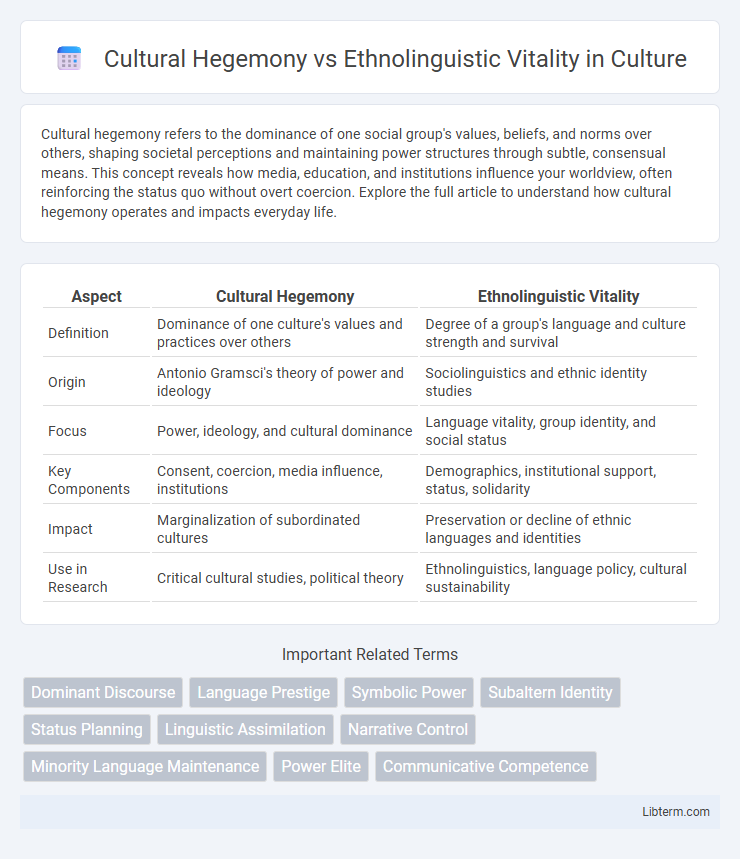Cultural hegemony refers to the dominance of one social group's values, beliefs, and norms over others, shaping societal perceptions and maintaining power structures through subtle, consensual means. This concept reveals how media, education, and institutions influence your worldview, often reinforcing the status quo without overt coercion. Explore the full article to understand how cultural hegemony operates and impacts everyday life.
Table of Comparison
| Aspect | Cultural Hegemony | Ethnolinguistic Vitality |
|---|---|---|
| Definition | Dominance of one culture's values and practices over others | Degree of a group's language and culture strength and survival |
| Origin | Antonio Gramsci's theory of power and ideology | Sociolinguistics and ethnic identity studies |
| Focus | Power, ideology, and cultural dominance | Language vitality, group identity, and social status |
| Key Components | Consent, coercion, media influence, institutions | Demographics, institutional support, status, solidarity |
| Impact | Marginalization of subordinated cultures | Preservation or decline of ethnic languages and identities |
| Use in Research | Critical cultural studies, political theory | Ethnolinguistics, language policy, cultural sustainability |
Understanding Cultural Hegemony: Definition and Origins
Cultural hegemony, a concept developed by Antonio Gramsci, refers to the dominance of a culturally diverse society by the ruling class, who manipulate the culture to impose their worldview as the societal norm. This process shapes social norms, values, and beliefs, ensuring the continuation of power structures by marginalizing alternative perspectives. The origins of cultural hegemony lie in Marxist theory, emphasizing ideological control over economic dominance, influencing social institutions such as media, education, and religion to maintain cultural consensus.
The Concept of Ethnolinguistic Vitality Explained
Ethnolinguistic vitality refers to the degree to which a language and its associated cultural group can sustain and promote its presence and identity within a larger society, encompassing factors like status, demographic strength, and institutional support. Unlike cultural hegemony, which involves dominant groups imposing their culture and language to maintain control, ethnolinguistic vitality emphasizes the capacity of minority groups to resist assimilation and preserve their unique linguistic and cultural heritage. The concept highlights how language maintenance, positive group self-perception, and community solidarity contribute to the survival and empowerment of ethnolinguistic groups.
Key Differences Between Cultural Hegemony and Ethnolinguistic Vitality
Cultural hegemony refers to the dominance of a particular culture or ideology that shapes societal norms and values, often marginalizing minority groups. Ethnolinguistic vitality measures the strength and survival prospects of an ethnic group's language and culture within a community. Key differences include cultural hegemony's emphasis on power and control over social narratives, whereas ethnolinguistic vitality focuses on the resilience and active maintenance of an ethnic group's linguistic and cultural identity.
Historical Case Studies Illustrating Cultural Hegemony
Historical case studies illustrating cultural hegemony include the British Empire's imposition of English language and cultural norms across India, systematically marginalizing local languages and traditions to maintain control. Similarly, the French colonial administration in Algeria promoted French cultural values while suppressing Berber and Arabic languages, aiming to assimilate indigenous populations and weaken ethnic identities. These examples demonstrate how dominant powers enforce cultural dominance to control ethnolinguistic vitality within colonized societies.
Factors Influencing Ethnolinguistic Vitality in Minority Groups
Ethnolinguistic vitality in minority groups depends significantly on factors such as demographic strength, institutional support, and the prestige assigned to the language within the broader society. Cultural hegemony shapes these factors by influencing dominant norms, education systems, and media representation, often marginalizing minority languages. Strong community networks and positive group identity contribute to maintaining and enhancing ethnolinguistic vitality despite hegemonic pressures.
Impact of Cultural Hegemony on Language and Identity
Cultural hegemony shapes language use and identity by promoting dominant cultural norms that marginalize minority languages and identities, leading to language shift or loss among subordinate groups. This process diminishes ethnolinguistic vitality by restricting access to resources, institutional support, and social prestige necessary for maintaining minority languages. The impact often results in assimilation pressures, decreasing linguistic diversity and weakening the cultural distinctiveness of ethnic communities.
Resistance to Cultural Hegemony: Strategies for Linguistic Survival
Resistance to cultural hegemony involves strategic efforts to preserve ethnolinguistic vitality by promoting language education, community media, and cultural festivals that reinforce identity and pride. Minority language speakers utilize grassroots activism and digital platforms to counter dominant linguistic norms, ensuring the transmission of language to younger generations. These practices foster resilience against linguistic assimilation and support sustainable cultural diversity within hegemonic societies.
Measuring Ethnolinguistic Vitality: Tools and Methodologies
Measuring ethnolinguistic vitality involves assessing factors such as group status, demographic strength, and institutional support to determine a community's ability to sustain its language and culture. Tools like surveys, sociolinguistic interviews, and vitality scales quantify these components, providing data on language use, attitudes, and intergroup relations. Methodologies often combine qualitative and quantitative approaches, enabling researchers to analyze the dynamic interplay between cultural hegemony and ethnolinguistic resilience.
Globalization, Power Dynamics, and Cultural Domination
Cultural hegemony, as theorized by Antonio Gramsci, manifests through dominant groups maintaining power by shaping cultural norms and values, reinforcing global inequalities amid globalization. Ethnolinguistic vitality examines the capacity of a language community to sustain and assert its linguistic and cultural identity, crucial in resisting homogenizing forces exerted by dominant cultures. The interplay of power dynamics during globalization underscores how cultural domination can diminish ethnolinguistic vitality, leading to language shift, loss of cultural diversity, and challenges to minority group survival.
Policy Implications: Preserving Cultural Diversity and Language Rights
Policy implications of cultural hegemony versus ethnolinguistic vitality emphasize the need for legal frameworks that actively protect minority languages and cultural expressions to prevent dominance by a single cultural group. Implementing inclusive education policies and media representation safeguards ethnolinguistic vitality, fostering cultural diversity and social cohesion. Effective language rights policies support the maintenance of linguistic heritage, countering the erasure effects of hegemonic cultural forces.
Cultural Hegemony Infographic

 libterm.com
libterm.com